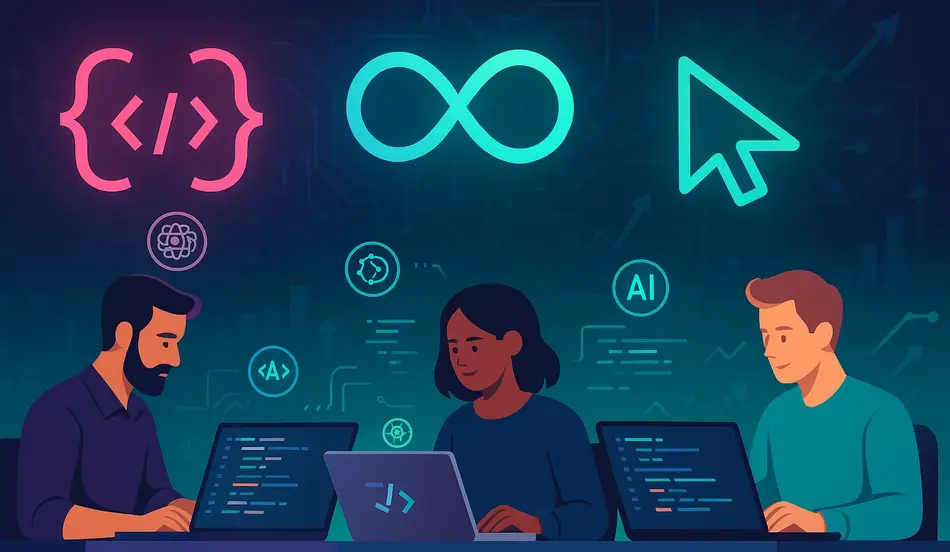Coding Tools in 2025
Are transforming the way software is built. Just a few years ago, beginner developers had to struggle through building a simple to-do list in React—dealing with states and hours of debugging. Now, with a wave of AI-powered tools, even non-coders can spin up fully designed web apps in minutes.
This shift is sometimes called vibe coding: sitting down with an idea, prompting an AI tool, and letting it generate most of the app for you. Tools like Lovable, Replit, and Cursor are leading the way. For some, this is an exciting time where anyone can turn their ideas into working products. For others, especially junior developers, it raises real concerns: if AI can already generate working apps, what happens to entry-level coding jobs?
In this article, we’ll explore the three biggest platforms in this new wave — Lovable, Replit, and Cursor — and more importantly, what they mean for your career. Whether you’re a non-coder thinking of breaking into tech, a bootcamp grad building a portfolio, or a working developer, understanding how these tools fit into your career path could be the difference between falling behind or pulling ahead.
Lovable – The Gateway for Non-Coders
If you’re completely new to coding, Lovable feels like magic. The interface is clean and guided. You type a prompt — something as vague as “Build a YouTube for dogs, modern but warm design, where users can upload videos of their pets” — and within a few minutes, you get a working prototype.
Lovable doesn’t just spit out code. It explains its design choices, builds UI components, sets up an upload modal, and even integrates with services like Supabase for databases. In short: Lovable leads, you follow.
That makes it perfect for entrepreneurs, creators, or busy professionals with zero technical background who want to turn an idea into a product without hiring a developer. If you’re a freelance marketer who wants to launch a side project, or a small business owner who needs a quick internal tool, Lovable is an entry point.
Career implication:
- For non-coders: Lovable is your entry to software creation. You don’t need to learn complex syntax, and you can still ship something that looks real.
- For aspiring developers: It’s a double-edged sword. While it can teach you the basics of how apps are structured, it risks turning you into a “prompt monkey” rather than a real coder. Without deeper skills, you may hit a ceiling quickly.
- For professionals: It’s a time saver, but also a reminder the bar for “basic apps” has been permanently lowered.
The limitation is that Lovable is a guided sandbox. Real-world apps need more than friendly interfaces — they need performance tuning, security, and maintainability. Lovable won’t give you those. For long-term careers, it’s a launching pad, not a destination.
Replit – For Builders Who Want to Prototype Fast
If Lovable feels like training wheels, Replit is like hopping on a scooter. It still helps you a lot, but it assumes you’re willing to get your hands dirty.
Replit is not new it’s been around for years as an online IDE where developers could code, test, and run apps directly in the browser. But its recent AI upgrades have turned it into a vibe coding powerhouse. With the same “YouTube for dogs” prompt, Replit will generate a preview (BarkTube, in one test case) and then build out the full app. Unlike Lovable, it doesn’t just stop at UI it includes user authentication, video feeds, upload pages, and more.
The tradeoff: it takes longer to generate. In some cases, minutes longer than Lovable. But when it’s done, you often get a more functional app out of the box.
Career implication:
- For students and bootcamp grads: Replit is a dream portfolio builder. You can launch apps that actually work, with features like logins, databases, and media uploads. That’s far more impressive to hiring managers than static landing pages.
- For indie hackers: You can test product ideas in days instead of weeks. Replit can help you validate startup concepts without a large engineering team.
- For career developers: It’s a rapid prototyping tool. You won’t use it for enterprise-grade systems, but it’s a great way to experiment, mock up ideas for stakeholders, or teach juniors.
Replit is the middle ground between toy apps and serious codebases. If Lovable is for non-coders, Replit is for ambitious learners who want more depth, and developers who want to cut prototyping time.
Cursor – The Developer’s Copilot
While Lovable and Replit lead the coding, Cursor plays a very different role: it assists.
Cursor is a developer’s IDE where AI is baked in at every step. It will autocomplete, refactor, debug, and explain code. But it won’t hold your hand — you need to know how to run npm install, set up a local environment, and manage dependencies. Cursor assumes you’re already technical.
For a beginner with no coding background, Cursor will feel intimidating. For a developer, it feels like a superpower. In one test, Cursor used React and Tailwind by default, showing that it builds using industry-standard frameworks. That makes it practical for professional projects, unlike Lovable or Replit, which are better suited for prototypes.
Career implication:
- For junior developers: Learning Cursor early will give you a competitive edge. Companies want developers who can work faster and smarter with AI, not against it.
- For mid-level and senior developers: Cursor is a force multiplier. Instead of spending hours debugging, you can fix errors in minutes. That means you deliver more, increasing your value to employers or clients.
- For non-coders: Cursor isn’t for you unless you’re committed to learning the basics of programming first.
In other words: Cursor won’t replace developers. But it will replace developers who don’t know how to use AI tools.
What This Means for Your Career
The rise of vibe coding tools is not just a trend. It’s a shift in how careers in tech (and beyond) will be built in the 2020s.
Here are three realities you need to understand:
1. Entry-Level Coding Jobs Are Shrinking
Tasks that used to be assigned to junior developers like building UIs, writing boilerplate code, or setting up prototypes are now handled faster and cheaper by AI tools. This means the bar for “entry-level” is moving up. Employers will expect new developers to know how to use these tools effectively, not compete with them.
2. Bootcamps and Self-Learners Must Evolve
Learning syntax alone is no longer enough. Bootcamps that train developers to “just build CRUD apps” risk producing graduates who are already obsolete. Instead, curricula need to shift toward:
- AI-assisted development workflows (how to prompt, debug, and integrate AI tools).
- Architecture and systems thinking (what AI can’t do well yet).
- Deployment and scaling (real-world DevOps and cloud management).
3. Non-Coders Now Have a Pathway to Tech Careers
In the past, if you wanted to break into tech, you had to spend months or years learning coding basics before shipping your first project. Now, with tools like Lovable or Replit, you can build and launch apps almost instantly. That means marketers, designers, and entrepreneurs can now participate in the software economy without full technical training.
The flip side: without deeper skills, you’ll plateau. Non-coders who want to build long-term careers will eventually need to learn how systems work beyond the AI layer.
4. Advanced Developers Gain Even More Leverage
Senior developers who master AI tools can deliver 2x–5x the output of those who don’t. They can prototype faster, debug smarter, and architect systems more efficiently. In many ways, AI is becoming like the calculator for coders: you still need to understand the math, but you’d be crazy not to use the calculator.
Future-Proof Your Tech Career
Search WhatJobs for roles in AI-assisted development, DevOps, cloud, and system architecture—careers where coding skills evolve, not disappear.
Search Tech Jobs →Final Thoughts
Vibe coding isn’t about replacing humans with AI. It’s about changing what humans focus on. Instead of struggling with boilerplate, developers can focus on strategy, architecture, and creativity. Instead of waiting for developers, non-technical professionals can launch their own prototypes and ideas.
For your career, the message is clear:
- If you’re a non-coder, Lovable and Replit are your entry point — but don’t stop there.
- If you’re a learner, use Replit to build real projects and start building a portfolio employers can’t ignore.
- If you’re a working developer, adopt Cursor (or similar tools) as your copilot — because those who don’t will fall behind.
The future of coding is not syntax. It’s collaboration between humans and AI. The question is: will you learn to collaborate, or will you be replaced by those who do?
FAQs
1. Which tool is best for beginners who don’t know how to code?
Lovable is the easiest for beginners. You can build functional prototypes without writing a single line of code. However, Replit is a better long-term choice if you want to eventually learn coding basics and expand beyond toy apps.
2. Will AI vibe coding tools replace junior developers?
Not entirely, but they will reduce demand for traditional entry-level tasks like building UIs or simple apps. Junior developers who don’t adapt may struggle. Those who learn to work with these tools will stand out and remain employable.
3. How do these platforms affect coding bootcamps and self-learners?
Not entirely, but they will reduce demand for traditional entry-level tasks like building UIs or simple apps. Junior developers who don’t adapt may struggle. Those who learn to work with these tools will stand out and remain employable.
4. Which platform gives the best career advantage right now?
For non-coders, Replit provides the best mix of usability and depth. For developers, Cursor offers the most career leverage because it integrates with professional workflows. Lovable is fun and fast but best seen as an entry point, not a long-term solution.




